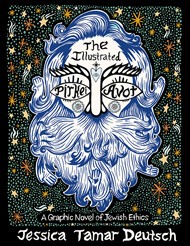Here's something of a novelty: a review of a book that was published nearly 30 years ago. Even more of a novelty is the fact that this review has something of a sectarian slant to it. While I have generally not singled out any religious preference for special attention, this post cannot fail to do so because this is a book on Pirkei Avot by two scholarly advocates of Reform Judaism in the United States.
As an orthodox Jew by persuasion and practice, I cannot pretend to be an expert on the Reform movement in the States. This review will not therefore discuss its principles and doctrines. My interest here is solely focused on what the book under review has to say about Avot and how it says it.The book, Pirke Avot: A Modern Commentary on Jewish Ethics, was published in 1993 by the UAHC Press. The authors are Leonard Kravitz and Kerry M. Olitzky, both of whom held posts with the Hebrew Union College and worked as congregational rabbis. Finding this work in my local second-hand book shop, I was intrigued. What would it say about the Ethics of the Fathers?
I had expected to find some fairly revolutionary, not to say shocking, religious pronouncements in the commentary on the six chapters of Avot. The big shock, however, was that there weren't any. The authors took an eclectic approach to their choice of sources, limiting themselves to just five: the Avot deRabbi Natan, Maimonides, the commentary ascribed to Rashi, Rabbi Ovadyah MiBartenura and Rabbi Yom Tov Lipman Heller's Tosafot Yom Tov. For the benefit of readers who may not appreciate the significance of this selection, it is notable that all five belong firmly within the orthodox camp and none is modern. The author of the most recent of these works, Rabbi Yom Tov Lipman Heller, died in 1654.
Taken as a whole, the treatment of these venerable sources is most respectable. In the main, each mishnah or baraita is accompanied by a translation and a brief extract of one or more of the sources mentioned above that seeks to elucidate or contextualise it. There are a small number of exceptions, where the authors add or substitute their own comments for those of the sages, of which the most puzzling is that which follows Avot 4:26 (where Rabbi Yose ben Yehudah likens learning from the young and the old to, respectively, drinking wine that is raw or mature) and 4:27 (the account of new jars containing old wine and old jars that don't even contain new wine). The sole commentary on the two mishnayot reads:
"The use of wine growing and wine making as symbols suggests how much viticulture was part of the ancient Jewish and general world".
This comment reflects the general drift of this book in treating Avot as a useful reference point for the study of Jewish life and rabbinical thought in the mishnaic period.
There is a further issue to address here: where is the Reform content of this book?
Each of the six chapters of Pirkei Avot is followed by two further sections. The first add-on consists of short explanations, penned by the authors, of some of the concepts and issues touched upon in the preceding chapter. In these we also read a little about the Reform positions on, for instance, rabbinic legislation, reward and punishment, this world and the next, and cremation. These explanations are brief and matter-of-fact, and certainly not "preachy".
The second add-on, called "gleanings", consists of a collection of short passages that have direct or tangential reference to a mishnah or baraita in the chapter to which they are appended. All are written by influential figures within the Reform movement from the United States and beyond.
Taken individually and collectively, these "gleanings" are far more powerful than the teachings in Avot and the accompanying commentary are allowed to be. Most are stylistically elegant and eloquent, designed to stimulate the mind and stir the emotions. Strange to say, if one were to blank out the name of the authors of many of these passages, one might easily imagine that they had been spoken by a contemporary orthodox rabbi.
Nonetheless I was left feeling uncomfortable about this book. Admittedly it was neither a critique of orthodox/traditional Judaism nor a hard sell for Reform. It did however make me think of an exercise in "bait-and-switch". My attention had been caught by the fact that this was a modern commentary -- but I had assumed that it was a modern commentary on Avot. In essence, it was not. The subtitle does state that the book is a "modern commentary on Jewish ethics" -- which it is. But the choice of Maimonides and the rest, the selection of source materials that were not modern and did not engage with any discussion of Jewish ethics, rather suggested that their inclusion may have been intended to show that the rabbis of the mishnah spoke only to their peers and that the sages of yesteryear had nothing to offer the then modern world of 1993.
In other words, the reader will receive the impression that "old" Judaism is a closed book, and that Jewish ethical narrative has now relocated to the "gleanings".
I would be curious to discover whether any readers of this blog have read this book too. If there are, I hope that they will share their opinions with the rest of us.














